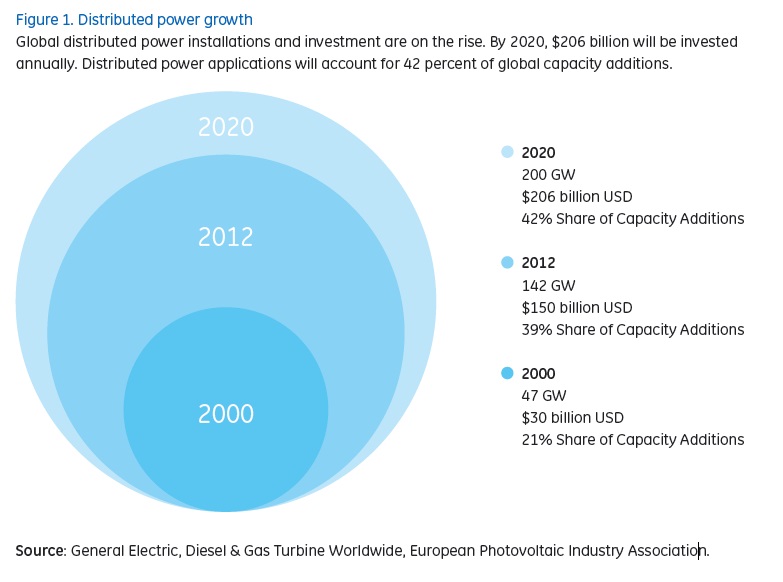Brandon Owens / GE / www.ge.com

The rise of distributed power is being driven by the same forces propelling the broader decentralization movement: distributed power technologies are more widely available, smaller, more efficient and less costly today than they were just a decade ago.
A grand transformation is underway. A wave of decentralization is sweeping the globe and changing the way we live, work and play. The organization of resources and people is moving away from centralized systems toward integrated networks that include both distributed and centralized elements. Although there is no standard definition, distributed power technologies are less than 100 MW — and typically less than 50 MW which is the limit that systems can accommodate at distribution voltages. The portfolio of distributed power technologies includes diesel and gas reciprocating engines, gas turbines, fuel cells, solar panels and small wind turbines. Distributed power technologies can stand alone, or they can work together within a network of integrated technologies to meet the needs of both large and small energy users.
The trend is pervasive. Telecommunications, computing, retail, and entertainment have all moved toward decentralization. We are at the beginning stages but the decentralization movement has the potential to enable unprecedented productivity gains and improve living standards for all. Electric power systems are riding the wave of decentralization through the deployment and use of “distributed power” technologies.
When deployed, distributed power technologies create a decentralized power system within which distributed generators meet local power demand throughout the network.
The rise of distributed power is being driven by the same forces propelling the broader decentralization movement: distributed power technologies are more widely available, smaller, more efficient and less costly today than they were just a decade ago. But the rise of distributed power is also being driven by the ability of distributed power systems to overcome the constraints that typically inhibit the development of large capital projects and transmission and distribution (T&D) lines. Because they are small, they have lower capital requirements and can be built and become operational faster and with less risk than large power plants. In addition, distributed power systems can be incrementally added to meet growing energy needs.
Furthermore, some distributed power technologies are being propelled by the “Age of Gas,” an era of more widely available natural gas. Greater gas abundance creates opportunities for gas-fired distributed power systems. The emergence of virtual pipelines — a collection of technologies designed to move natural gas from the end of the pipeline to remote uses — have the potential to amplify the Age of Gas and make gas-fired distributed power technologies even more ubiquitous. Together, the net result is an increase in distributed power investment and capacity installations that are expected to continue over the next decade. In 2012, $150 billion was invested in distributed power technologies including gas turbines, reciprocating engines, and solar PV in electric, power, mechanical drive and propulsion applications globally. About 142 GW of distributed power capacity was ordered and installed.
During the same year, GE estimates that 218 GW of central power capacity was ordered. This means that distributed power capacity additions accounted for about 39 percent of total global capacity additions. By 2020 distributed power will play an even larger role. GE estimates that annual distributed power capacity additions will grow from 142 GW in 2012 to 200 GW in 2020. That’s a 58 GW increase and represents an average annual growth rate of 4.4%. During this period, investment in distributed power technologies will rise from $150 billion to $206 billion. As a point of reference, during this same period, global electricity consumption will rise from 20.8 to 26.9 terrawatt-hours (TWh). This represents an average annual growth rate of 3.3%.
Thus, through the end of the decade, distributed power capacity additions will grow at a rate that is nearly 40 percent faster that global power demand. The proliferation of distributed power systems will benefit nations, industries and people around the world because power use is critical to human and economic development. Research has shown that increasing electricity use is positively correlated with advances in income, education and health. This is particularly true in developing countries such as China, India and Brazil that have lower per capita income levels; and this is where the demand for distributed power is the greatest today.
Read Owens’ full paper at:
http://www.eenews.net/assets/2014/02/25/document_gw_02.pdf
Filed Under: News




